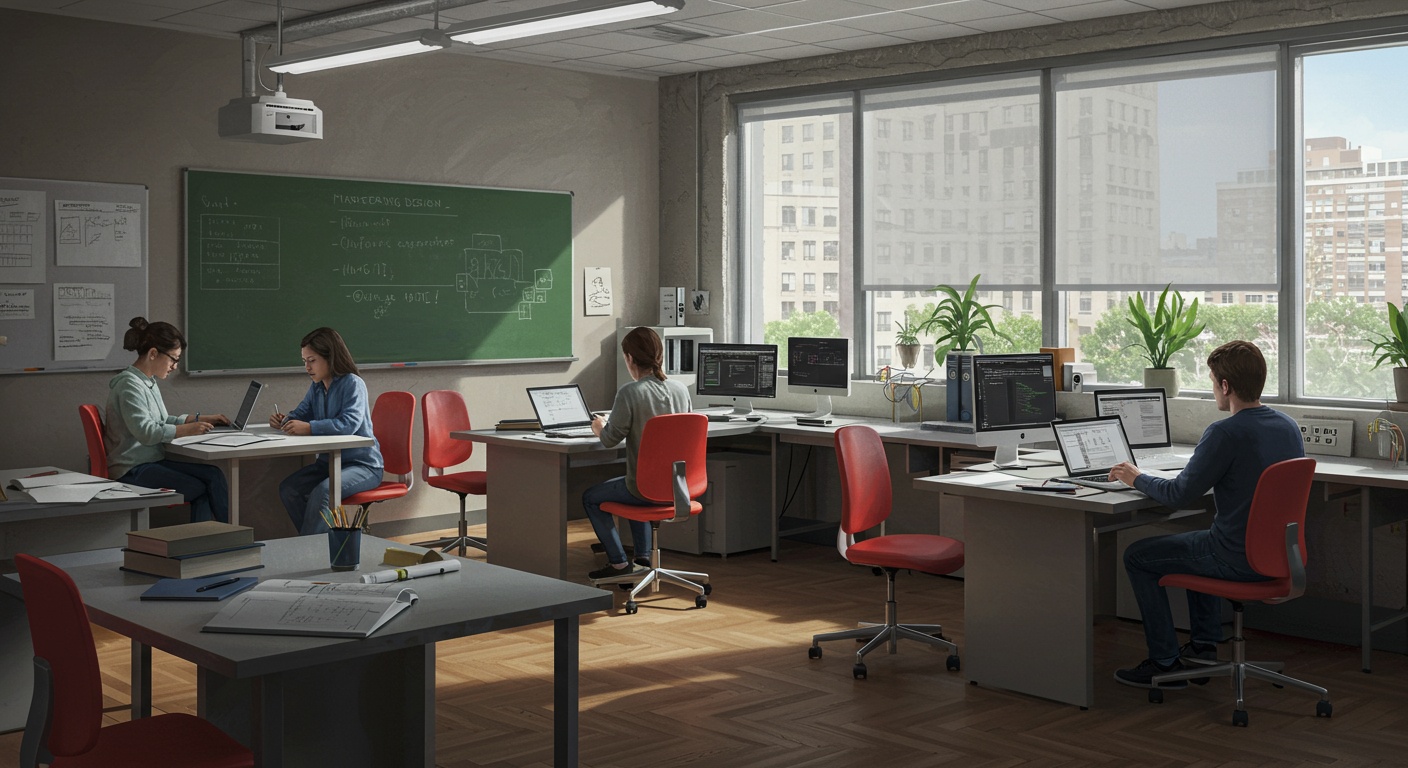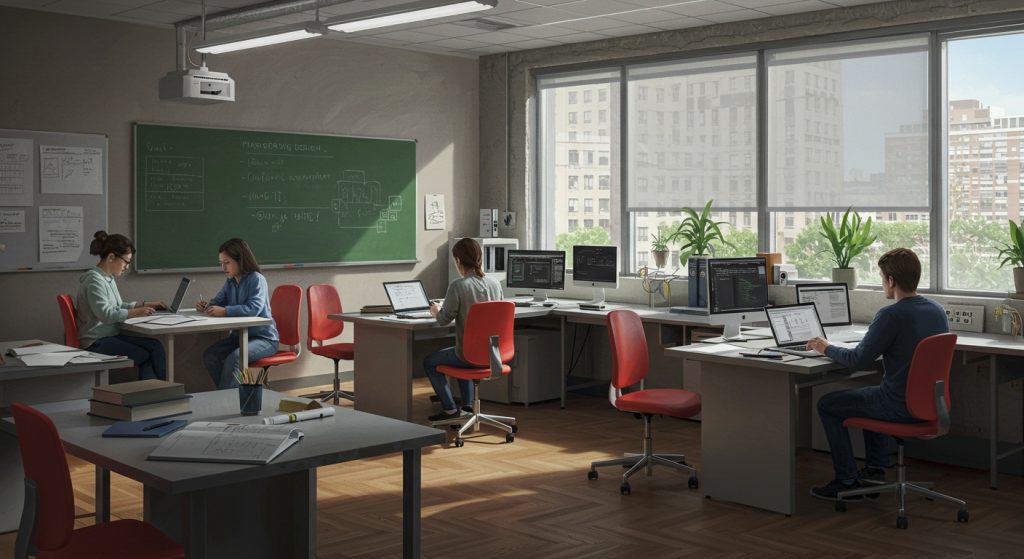Ever wondered how MIT’s cutting-edge research translates into tangible innovations? It starts with design. Mastering the right software is your entry point. Forget generic tutorials; we’re diving into the tools actually used to build the next generation of robots, sustainable infrastructure. Personalized medicine. From generative design algorithms in Autodesk Fusion 360 optimizing structural integrity to advanced simulations in COMSOL predicting material behavior, these aren’t just skills, they’re superpowers. We’ll explore how recent advancements in AI-powered design assistants are streamlining workflows and enabling rapid prototyping, ensuring you’re equipped to tackle real-world challenges with MIT-grade precision and efficiency. Let’s build the future, one design at a time.

The Foundation: CAD Software for 3D Modeling
At the heart of any robust engineering and design program lies a strong foundation in Computer-Aided Design (CAD) software. These tools allow students to translate ideas into precise 3D models, enabling virtual prototyping, simulation. Manufacturing preparation. MIT, renowned for its hands-on approach, emphasizes proficiency in several industry-standard CAD packages. These include:
- SolidWorks: A parametric, feature-based solid modeling software. This means that models are built using parameters and features (like extrudes, cuts. Fillets), making them easy to modify. Changes to one parameter automatically update the entire model. SolidWorks is widely used in mechanical engineering for designing parts, assemblies. Creating detailed drawings for manufacturing.
- AutoCAD: Primarily a 2D drafting software. Also capable of 3D modeling. AutoCAD is essential for creating technical drawings, blueprints. Schematics. Its versatility makes it a staple in architecture, civil engineering. Manufacturing.
- Fusion 360: A cloud-based CAD/CAM/CAE tool. It offers a comprehensive suite of tools for 3D design, simulation. Manufacturing. Its cloud-based nature facilitates collaboration and accessibility, making it a popular choice for both students and professionals.
The choice of CAD software often depends on the specific project and department. Mechanical engineers might lean towards SolidWorks for its robust part modeling capabilities, while architects might prefer AutoCAD for its 2D drafting tools. Fusion 360’s cloud-based accessibility makes it a versatile option across disciplines.
Simulation and Analysis: Validating Your Designs
Creating a 3D model is only the first step. Before physical prototypes are built, simulation and analysis software plays a crucial role in validating designs and identifying potential issues. MIT emphasizes the use of these tools to ensure that designs are structurally sound, thermally efficient. Perform as intended. Some commonly used software includes:
- ANSYS: A powerful finite element analysis (FEA) software used for simulating structural mechanics, fluid dynamics, heat transfer. Electromagnetics. ANSYS allows engineers to predict how a design will behave under different conditions, optimizing performance and preventing failures.
- MATLAB/Simulink: While primarily known for numerical computation and algorithm development, MATLAB and Simulink are also used for simulating dynamic systems and control systems. This is particularly relevant in robotics, aerospace. Control engineering.
- COMSOL Multiphysics: Another FEA software capable of simulating a wide range of physical phenomena, including structural mechanics, fluid dynamics, electromagnetics, acoustics. Chemical reactions. COMSOL’s strength lies in its ability to handle multiphysics simulations, where multiple physical phenomena interact with each other.
For example, a team designing a new drone might use ANSYS to simulate the structural integrity of the drone’s frame under various flight conditions. They might then use MATLAB/Simulink to simulate the drone’s flight dynamics and control system. Finally, they could use COMSOL to simulate the thermal performance of the drone’s battery pack.
Digital Fabrication: From Design to Reality
MIT’s “mens et manus” (mind and hand) motto is reflected in its emphasis on hands-on learning and digital fabrication. Students have access to state-of-the-art fabrication facilities, including 3D printers, laser cutters, CNC mills. Electronics assembly equipment. To effectively utilize these facilities, students need to be proficient in software that prepares designs for fabrication. This includes:
- Simplify3D/Cura: Slicing software used to prepare 3D models for 3D printing. These programs take a 3D model as input and generate a toolpath that the 3D printer follows to build the object layer by layer. They allow users to control various printing parameters, such as layer height, infill density. Support structures.
- CAM Software (e. G. , Fusion 360 CAM, Mastercam): CAM (Computer-Aided Manufacturing) software is used to generate toolpaths for CNC machines. These programs take a 3D model as input and generate a set of instructions for the CNC machine to cut the part out of a block of material.
- Adobe Illustrator/Inkscape: Vector graphics editors used for designing patterns and layouts for laser cutting. These programs allow users to create precise 2D designs that can be etched or cut from various materials, such as wood, acrylic. Metal.
Imagine a student designing a custom enclosure for an electronics project. They would use CAD software to create the 3D model, then use slicing software to prepare it for 3D printing. Alternatively, they could use a vector graphics editor to design the enclosure’s panels and then use a laser cutter to cut them from a sheet of acrylic.
PCB Design: Bringing Electronics to Life
For students involved in electrical engineering, robotics. Other fields that require custom electronics, proficiency in printed circuit board (PCB) design software is essential. These tools allow students to design the layout of electronic components and traces on a PCB, which is the foundation of most electronic devices. Popular PCB design software includes:
- KiCad: An open-source PCB design suite that includes schematic capture, PCB layout. A Gerber file viewer. KiCad is a powerful and versatile tool that is widely used in both academia and industry.
- Eagle: A popular PCB design software with a user-friendly interface and a large library of components. Eagle offers both free and paid versions, making it accessible to students and hobbyists.
- Altium Designer: A professional-grade PCB design software used by many companies in the electronics industry. Altium Designer offers advanced features for high-speed design, signal integrity analysis. Manufacturing preparation.
The workflow for PCB design typically involves creating a schematic diagram of the circuit, then using the PCB layout software to place components and route traces. The software also allows users to generate Gerber files, which are used by PCB manufacturers to fabricate the board.
Beyond the Core: Specialized Software and Emerging Trends
While the software mentioned above represents the core tools used at MIT, students often encounter specialized software depending on their specific research interests and projects. This might include:
- Rendering Software (e. G. , Blender, Keyshot): For creating photorealistic images and animations of designs. This is particularly useful for communicating design concepts to clients and stakeholders.
- Virtual Reality (VR) and Augmented Reality (AR) Development Tools (e. G. , Unity, Unreal Engine): For creating immersive experiences and interactive prototypes. These tools are becoming increasingly vital in fields such as architecture, product design. Training.
- Data Visualization Tools (e. G. , Tableau, Python with Matplotlib/Seaborn): For analyzing and visualizing data generated from simulations, experiments. User studies. This is essential for understanding design performance and identifying areas for improvement.
The field of design is constantly evolving. New software tools are emerging all the time. MIT encourages students to explore these tools and develop their own unique skill sets. For example, the increasing popularity of generative design, where algorithms are used to explore a wide range of design options, is leading to the adoption of software like Autodesk’s Dreamcatcher.
A Word of Advice: Focus on Fundamentals, Embrace Lifelong Learning
While mastering specific software packages is crucial, it’s equally crucial to interpret the underlying principles of design and engineering. A strong foundation in mathematics, physics. Computer science will enable you to adapt to new software and technologies throughout your career. Remember that software is just a tool; the real power lies in your creativity, problem-solving skills. Ability to apply your knowledge to real-world challenges. Embrace lifelong learning and stay curious about new developments in the field of design. The software landscape will continue to evolve. The fundamental principles will remain constant.
Conclusion
Mastering design at MIT hinges not just on grasping software functionalities. On cultivating a designer’s mindset. Think beyond the tools; consider how Figma’s collaborative features can streamline teamwork, or how generative design in Fusion 360, a rising trend, can push creative boundaries. My personal tip? Dedicate time to recreating designs you admire. This sharpens your skills and exposes you to diverse techniques. Remember, the software is merely a vehicle. The true power lies in your ability to envision, iterate. Communicate your ideas effectively. Embrace continuous learning, explore emerging technologies. Never shy away from experimentation. Like any skill, proficiency in these tools requires dedication. The ability to shape the world around you through design is a reward worth striving for. Now, go forth and build something amazing, using resources like career services for support here.
More Articles
University Course: Crafting Your Personal Brand for Career Success
Mastering University: Proven Strategies to Excel in Challenging Courses
Building Your Network: Effective Networking in Business School Explained
Unlocking Your Potential: Developing Leadership Skills in Business Management
FAQs
So, I’m hearing MIT’s design program is pretty intense. What kind of software are we really talking about needing to know?
Intense is one word for it! Think industry-standard tools. With a focus on pushing boundaries. You’ll definitely want a solid grasp of CAD software like SolidWorks or Fusion 360. Then, Adobe Creative Suite (Photoshop, Illustrator, InDesign) is crucial for visual communication. Simulation software (like ANSYS or COMSOL) is vital, depending on your specialization. It really boils down to CAD for creating, Adobe for presenting. Simulation for testing.
Okay, CAD and Adobe are obvious. But what about coding? Do I need to be a programmer to succeed in design at MIT?
You don’t need to be a programmer programmer. Understanding basic scripting and potentially some interactive design tools is super helpful. Think Processing or maybe even a bit of Python. It’s less about building full-blown applications and more about prototyping interactive elements or automating design tasks. A basic understanding goes a long way.
What if I’m coming in with zero experience in, say, SolidWorks? Am I totally screwed?
Definitely not screwed! MIT knows not everyone arrives a pro. They’ll have introductory courses and plenty of resources to get you up to speed. The key is to be willing to learn and put in the practice. Don’t be afraid to ask questions – everyone starts somewhere!
I’m torn between focusing on SolidWorks and Fusion 360. Which one is ‘better’ for MIT’s design program?
There’s no universally ‘better’ option, honestly. Both are powerful CAD programs. SolidWorks is a classic in engineering, while Fusion 360 is cloud-based and has some great collaboration features. I’d recommend checking which one is emphasized in the specific courses you’re interested in. Knowing either one will give you a great foundation for the other.
Beyond the basics, what’s a piece of software that might give me an edge in the program?
That’s a great question! Depending on your focus, learning a bit of Grasshopper (a visual programming language for Rhino) could set you apart. It’s fantastic for parametric design and exploring complex forms. It’s not strictly ‘essential,’ but it’s a powerful tool that can really elevate your work.
Is there any software specifically geared towards sustainable design that I should look into?
Absolutely! Look into software for Life Cycle Assessment (LCA). SimaPro is a popular one. There are others. These tools help you assess the environmental impact of a product from cradle to grave, which is increasingly essential in design. Knowing how to use them shows you’re thinking about the bigger picture.
Okay, last one! How crucial is mastering rendering software like Keyshot or Blender for showcasing my designs?
Pretty darn essential! A great design can be lost if it’s presented poorly. Keyshot is known for its ease of use and photorealistic results, making it great for quick renders. Blender is a free and open-source option that’s incredibly powerful, though it has a steeper learning curve. Either way, learning to create compelling visuals is a must.

